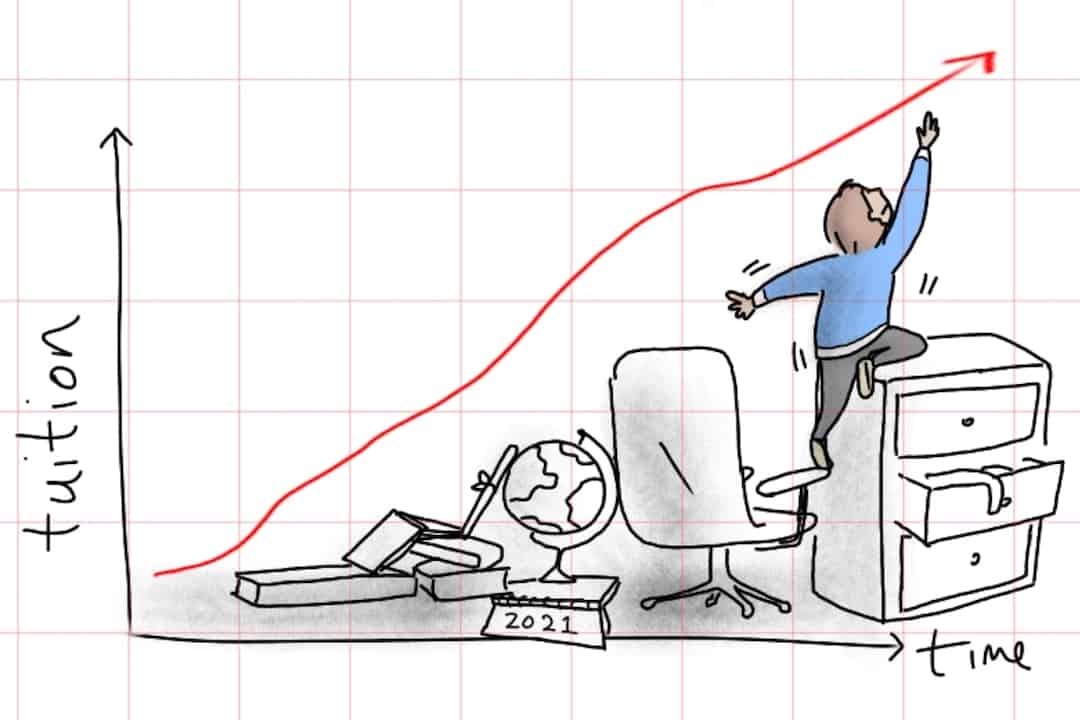Over the past 20 years, U of T has grown increasingly reliant on tuition fees as a source of revenue — particularly high international tuition fees. In the past decade, international tuition fees at U of T have increased by 41.2 per cent, and they’re continuing to rise.
Although the university has never itself decided to decrease tuition from year to year, many student groups are lobbying the administration for lower fees. Particularly due to the pandemic, at the beginning of the 2020–2021 academic year, several student groups published letters to the U of T administration demanding that tuition be decreased. The university claimed that tuition fees had to remain the same to pay for digital infrastructure.
For this reason and a number of others, tuition advocacy has become difficult, forcing students to pursue several efforts at once in order to alleviate financial pressure.
A brief history of tuition
Tuition has been on the rise in Canada since the 1990s, both as an amount students must pay and a proportion of university revenue. Ontario serves as a particularly intense microcosm in this broader trend.
In the 2016–2017 academic year, tuition accounted for 55 per cent of Ontario universities’ revenue, up from 20 per cent in 1990. Fees for domestic and international undergraduates increased by 25 per cent and 100 per cent, respectively, over the last decade.
Regulation plays a big role in how tuition has changed since the ’90s. Prior to 1998, the Ontario government decided how much universities were allowed to charge students. However, that year, Ontario decided to deregulate certain programs and introduce fee differentiation, which allowed universities to charge different fees for different programs.
While universities gained more control over program fees, the government still capped the per cent amount by which universities could increase tuition each year.
International tuition fees have been deregulated since 1996 and are increasing at a rapid rate. The discrepancies between domestic and international fees at U of T make the effects of these policies immediately clear.
In the 2020–2021 academic year, first-year international students entering the Faculty of Arts & Science paid $57,020 compared to a domestic tuition of $6,100. From 2010–2020, international tuition has risen by $33,542 while — prior to the tuition freeze Doug Ford introduced in 2019 — domestic tuition rose by $1,564.
https://plotly.com/~marta.thevarsity/3/
Ford’s provincial government cut domestic tuition fees in the 2019–2020 year by 10 per cent and froze tuition for the 2020–2021 academic year. But these cuts were not accompanied by increased funding for universities, and also accompanied cuts to the Ontario Student Assistance Program. As a result, universities had to compensate for the loss of revenue, and they usually do so by either increasing international tuition or international student enrolment.
Student advocacy
The COVID-19 pandemic has renewed many students’ passion for tuition advocacy. At the beginning of the year, several student groups, including the University of Toronto Students’ Union (UTSU) and the International Student Advocacy Network (ISAN), demanded that the university decrease tuition.
However, the university did not decrease tuition, claiming that it had to invest in digital infrastructure for the coming year and that the quality of education would remain the same. The UTSU compiled a report based on student consultation, which found that for most students, the quality of education has been reduced since courses moved online. While the university was receptive to most of the report’s recommendations, it remained silent on the topic of decreasing tuition.
The UTSU also plans to file a Freedom of Information request to receive budgetary information on certain previously deregulated programs.
A spokesperson for the university noted that if government funding doesn’t increase, a reduction in fees would require changes to hiring plans, services, and investment in financial aid.
While student groups have been skeptical of the connection between higher fees and better service quality, they agree that the problem stems from a lack of government funding. In 2020–2021, student fees accounted for 65 per cent of U of T’s revenue, compared to around 22.3 per cent contributed from government grants.
https://plotly.com/~marta.thevarsity/5/
In response, much of the UTSU’s advocacy will now be focused at a provincial level. As the government expects a new tuition framework to come out before the beginning of the next academic year, the UTSU submitted recommendations to the provincial government in late December. These recommendations include maintaining the tuition freeze and increasing operating grants.
International students have also been busy advocating for lower tuitions, especially since the university has grown so reliant on them as a source of income. Since its inception in summer of 2020, the ISAN has been working to establish connections to different levels of administration.
While the ISAN has met with university administration and voiced its concerns, the university showed no indication that it would decrease tuition fees next year. In the meantime, the ISAN will try to link international students to resources such as reproductive services and financial advice.
The ISAN speculates that one reason the university and government may have little reason to listen to their demands is because they are not citizens and, therefore, hold little political power. A spokesperson for the ISAN claimed that they have been told by the administration that their high tuition rates account for the “real cost” of their education.
However, the ISAN noted that their tuition impacts the entire student community, not just international students. In an email to The Varsity, the ISAN argued that “all students benefit from those investments, but we’re the only ones paying more for it.”


